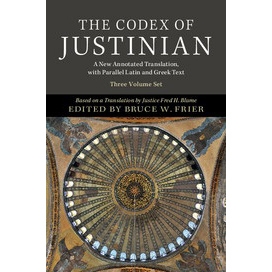News
The Key Reporter on The Codex of Justinian
December 01, 2015

Reprinted from The Key Reporter, published by the Phi Beta Kappa Society.
Phi Beta Kappa News
The Codex of Justinian
By TIMOTHY KEARLY
When the Cambridge University Press publishes Bruce Frier’s new edition of The Codex of Justinian in 2016, it will crown the labors of seven Phi Beta Kappas whose contributions span three centuries. The Codex was first issued in AD 529, amended in AD 534, and represents the great classical jurist’s attempt to harmonize the many conflicting laws that had been promulgated over the centuries that were causing confusion and delay in the courts of his time. It constitutes one part of the Justinian collection known as the Corpus Juris Civilis (CJC), or “the body of the civil law.” Though the Codex Justinianus influenced European law less than the more readable Digest, it still contains much to interest classicists, historians, theologians, and jurists.
The devotion of Samuel Parsons Scott (ΦBK, Miami University, 1866) to European history led him to spend many years of his life translating the entire Corpus Juris Civilis into English. Scott was a gentleman-scholar who shifted from authoring his Spanish travels to composing a history of the Moorish empire in Europe, and then to translating ancient, Roman-influenced laws—the Visigothic Code, and the Siete Partidas. In the course of researching and translating these laws he often had to refer to Justinian’s compilations and thus decided to take on the entire corpus. Unfortunately, Scott did not base his English translation on the best available Latin edition of the CJC, and critics found his work deficient. After its posthumous publication in 1932 as The Civil Law, the Roman law scholar W.W. Buckland wrote in a review that Scott “had at his disposal an adequate latinity and has produced a version written in an English which can be read with pleasure. But much more was needed, and the work cannot be said to satisfy these further requirements.”
Coincidentally at the same time a Justice of the Wyoming Supreme Court was working independently on his own translation. After suffering the frustration of his political ambitions Justice Fred H. Blume (ΦBK, University of Iowa, 1898) discovered in 1920 that there was no English translation of either the Codex Theodoseanus or the Codex Justinianus. The German immigrant wondered if he “might not be able to add [his] little mite to the culture of the world by translating at least one of these Codes,” as he described it later. Unlike Scott, Blume was well aware of the latest Roman law scholarship and therefore used the preferred Mommsen, Kruger, Kroll, and Schoell Latin edition for his translation of Justinian’s Code.
Blume finished his first draft of the Code in 1924, working only in the evenings after a full day’s employ on the Wyoming Supreme Court. He continued to revise and to write copious annotations for it throughout the 1930s. In 1933, Clyde Pharr, a professor of classics at Vanderbilt University, heard of Blume’s work and asked him to join Pharr’s “Project for a Variorum Translation into English of the Entire Body of Roman Law,” of which Blume’s translated Codex Justinianus was to be a part. While Pharr’s project did result in publication of The Theodosian Code (Princeton University Press, 1952), for which Blume’s work on Justinian’s Code was indispensable, the Code translation itself was never published, because Pharr could not acquire the necessary subvention. One of Pharr’s assistant editors for The Theodosian Code was Theresa Davidson (ΦBK, Oberlin, 1914).
Justice Blume’s 4,500-page manuscript of the “Annotated Justinian Code” lay largely forgotten in the University of Wyoming College of Law library until the library’s new director, Timothy Kearley (ΦBK, University of Illinois, 1971) discovered it in 1993. Recognizing its significance, he undertook the lengthy process of editing and transcribing it, finally publishing it on the web in 2007. Professor Bruce Frier (ΦBK, Trinity College, 1964) heard of Kearley’s project while it was underway and asked him if he would forward electronic versions as he proceeded, in order that Blume’s work might form the basis for the new translation to be made by the Anglo-American panel he had organized. And, yes, of the six Americans on that panel, four are Phi Beta Kappa members. In addition to Frier, there are: Dennis Kehoe, Dartmouth, 1977; Noel Lenski, Colorado College, 1989; and Charles Pazdernik, Cornell, 1990.
So, it seems fair to say that Phi Beta Kappas have been vital links in the chain of scholars that have transmitted this fundamental document of Western civilization from sixth century Constantinople to the English-speaking world of the twenty-first century. Somehow, that is not surprising.
Timothy Kearley (ΦBK, University of Illinois at Champaign-Urbana, 1971) is Professor Emeritus of Law at the University of Wyoming and a resident member of the Alpha of Wyoming chapter.
